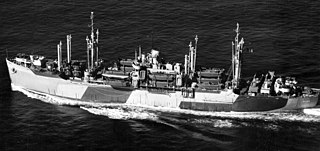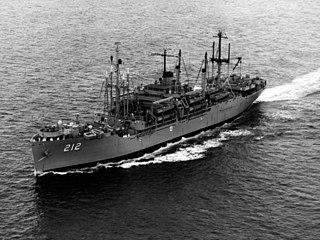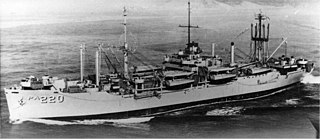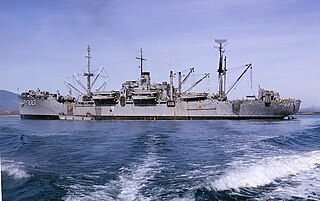Service history
World War II
After commissioning, Navarro moved to the Naval Supply Depot, San Francisco to take on stores. Then, in a series of moves about San Francisco Bay, the ship took on ammunition and degaussed. She commenced shakedown 1 December, with a twelve-day cruise to San Pedro, and 16 December, she commenced a week of amphibious training at San Diego.
Navarro got underway New Year's Day 1945 for Seattle, Washington, to embark troops and equipment for transport to the South Pacific. She departed Seattle 12 January, called at the Hawaiian Islands 20 January, reached Guadalcanal 10 February, where she offloaded cargo and troops, and then moved to Sunlight Channel, Russell Islands. At the Russells, Navarro participated in an intensive rehearsal for the invasion of Okinawa.
Invasion of Okinawa
Navarro arrived off Okinawa Easter Sunday 1945, the morning that US Forces invaded the island. The next two days were spent offloading troops and cargo, accomplished in record time. So effective was screening and air cover that, despite several air alerts, Navarro's gunners fired on hostile air contacts but three times.
Transport duties
After six days in the area, Navarro steamed for Guam. The morning of 12 April, she departed for the United States, via Pearl Harbor, arriving San Francisco 30 May; then transported troops and equipment to Seattle. She departed Seattle 21 June, for Ulithi via Eniwetok, but continued on to Okinawa where she commenced offloading 24 July, amidst frequent calls to General Quarters. Navarro then steamed to Ulithi, and was anchored in that lagoon when the Japanese surrendered.
She had been scheduled to return to the United States, but was hurriedly rerouted to the Philippines and arrived Leyte 23 August. A few days later she steamed for Yokohama, carrying occupation troops for the Yokohama district. Navarro next participated in Operation Magic Carpet, returning American troops home.
Second commission
Recommissioned 2 December 1950, Navarro transited the Panama Canal to join the Amphibious Force, Atlantic Fleet. During the next four years she operated out of Norfolk, Virginia, participating in both Mediterranean and Caribbean deployments.
She returned to the US Pacific Fleet in 1955, and made periodic deployments to the Western Pacific. Her 1956 WESTPAC cruise was marked by amphibious demonstrations held for the Korean Marines and Midshipmen at Chinhae, Korea.
During the summer of 1958, Navarro provided services for a series of atomic tests at Eniwetok. In 1960, she landed 1,200 Marines on Formosan beaches while participating in a mock amphibious invasion.
Laotian crisis
The Laotian situation entailed changes of embarkation plans for the 1st Battalion, 4th Marines, while Navarro was in Hawaii. Originally intended for a practice assault on California beaches, the Marines were instead carried under sealed orders to Okinawa.
After participating in large scale amphibious demonstrations for the president in January 1962, Navarro deployed to the Western Pacific 22 January, for a seven-month tour with the 7th Fleet. When a further deterioration of the Laotian situation seemed imminent, the president ordered a task force to move toward Indochina 12 May. Navarro carried a portion of the 1,800 embarked Marines of this force.
When aircraft carrier Valley Forge, Navarro, and dock landing ship Point Defiance arrived in the Gulf of Siam, they were directed to off-load their 1,800-man Battalion Landing Team by helicopter from the Gulf to Bangkok, Thailand. This force bolstered the Thai defense against possible attack by Laotian communists.
Navarro departed Okinawa 11 August and arrived Long Beach 25 August for upkeep and operational readiness training.
Project SHAD
Navarro was subjected to at least two simulated biological weapon attacks in the first half of 1963 under Project SHAD. [4]
Modernization overhaul
Upon return from her 1964 Western Pacific deployment, Navarro underwent a Fleet Rehabilitation and Modernization overhaul at Pacific Ship Repair Shipyard, San Francisco. Upon completion, she participated in Exercise "Silver Lance" 25 February-9 March 1965, off the southern California coast, and 27 April, she departed on another WESTPAC deployment.
Vietnam War
From 27 January through 16 February 1966, Navarro formed part of a special task unit which provided boating and support for the combat landing of 1,200 Marines in Southern Quang Ngai Province, Republic of Vietnam, in Operation Double Eagle. Over a dozen ships and 5,000 Marines and Sailors combined to mark "Double Eagle" as the largest amphibious operation up to that time since the Korean War.
Unit commendation
Navarro returned to Long Beach, California on 16 March, after 10 months and 27 days as part of the Amphibious Assault Forces of the 7th Fleet operating off Vietnam. For service in support of military operations in Vietnam during the period 1 January through 23 March 1968, Navarro received the Secretary of the Navy, Meritorious Unit Commendation. She rescued 43 seamen from the stranded British merchant ship Habib Marikar when it grounded on a reef in the South China Sea during typhoon Emma. In November 1967, Navarro's salvage efforts contributed directly to the salvage of landing ship-tank Clarke County, damaged and stranded on the coast of Vietnam. Navarro's officers and men carried out this salvage operation within range of enemy small arms and artillery.
Final decommission
Navarro continued to maintain a high state of readiness and provided amphibious expertise through both her west coast training operations and her deployments to the Western Pacific. Reclassified an amphibious transport, LPA-215, on 1 January 1969, she was decommissioned at San Diego.
On 20 August 1970, she was transferred to the Maritime Administration (MARAD) and placed in the National Defense Reserve Fleet, Suisun Bay Group, Benicia, California. She was permanently transferred to MARAD on 1 September 1971 and stricken on 1 December 1976, from the Naval Vessel Register.
On 19 February 1982, she was exchanged to Farrell Lines, Inc., who immediately sold her to C.W. Enterprise Investments, Inc., with the provision that she be scrapped within 24 months in either South Korea or Taiwan. She was withdrawn from the fleet 16 June 1982.

USS Talladega (APA/LPA-208) was a Haskell-class attack transport of the US Navy. She was of the VC2-S-AP5 Victory ship design type. Talladega was named for Talladega County, Alabama.

USS Paul Revere (APA/LPA-248) was the lead ship of the Paul Revere class of attack transport in the United States Navy. She was named for the early patriot and Founding Father, Paul Revere (1735–1818). She later served in the Spanish Navy as Castilla (L-21).

USS Point Defiance (LSD-31) was a Thomaston-class dock landing ship of the United States Navy. She was named for Point Defiance, a location in Pierce County, Washington, the site of a military reservation established by the U.S. Government in 1866. She was the second ship assigned that name. The construction of the first ship, Casa Grande-class dock landing ship Point Defiance (LSD-23), was canceled on 17 August 1945.

USS Tulare (AKA-112/LKA-112) was a Tulare-class attack cargo ship in service with the United States Navy from 1956 to 1986. She was sold for scrap in 2011.

USS Lenawee (APA-195) was a Haskell-class attack transport in service with the United States Navy from 1944 to 1946 and from 1950 to 1967. She was scrapped in 1975.

USS Pickaway (APA/LPA-222) was a Haskell-class attack transport that saw service with the US Navy in World War II, the Korean War and the Vietnam War. She was of the VC2-S-AP5 Victory ship design type and named after Pickaway County, Ohio.

USS Olmsted (APA-188) was a Haskell-class attack transport that saw service with the US Navy for the task of transporting troops to and from combat areas. She was of the VC2-S-AP5 Victory ship design type. Olmsted was named for Olmsted County, Minnesota.

USS Sandoval (APA-194/LPA-194) was a Haskell-class attack transport in service with the United States Navy from 1944 to 1946, from 1951 to 1955 and from 1961 to 1970. She was scrapped in 1983.

USS Magoffin (APA/LPA-199) was a Haskell-class attack transport in service with the United States Navy from 1944 to 1946 and from 1950 to 1968. She was scrapped in 1980.

USS Henrico (APA-45) was a Bayfield-class attack transport that served with the United States Navy in World War II, and subsequently in the Korean War, Cold War and Vietnam War.

USS Sarasota (APA/LPA-204) was a Haskell-class attack transport that saw service with the US Navy in World War II, Korean War Era and after. She was of the VC2-S-AP5 Victory ship design type. Sarasota was named for Sarasota County, Florida.

USS Tazewell (APA/LPA-209) was a Haskell-class attack transport in service with the United States Navy from 1944 to 1946. She was scrapped in 1973.

USS Telfair (APA/LPA-210) was a Haskell-class attack transport that saw service with the US Navy in World War II and the Korean War. She remained in service through most of the 1950s and 1960s, where she participated in various peacetime operations. Telfair was named for Telfair County, Georgia, which was itself named after Edward Telfair, the second Governor of the state, a member of the Continental Congress, and a signer of the Articles of Confederation.

USS Montrose (APA/LPA-212) was a Haskell-class attack transport in service with the United States Navy from 1944 to 1946 and from 1950 to 1969. She was scrapped in 1970.

USS Mountrail (APA/LPA-213) was a Haskell-class attack transport of the US Navy in World War II, the Korean War and Vietnam War era. She was of the VC2-S-AP5 Victory ship design type. Mountrail was named for Mountrail County, North Dakota.

USS Okanogan (APA/LPA-220) was a Haskell-class attack transport that saw service with the US Navy in World War II, the Korean War and the Vietnam War. She was of the VC2-S-AP5 Victory ship design type and named after Okanogan County, Washington.

USS Renville (APA-227) was a Haskell-class attack transport that saw service with the US Navy in World War II, the Korean War and the Vietnam War.

USS Bollinger (APA-234) was a Haskell-class attack transport in service with the United States Navy from 1944 to 1947. She was scrapped in 1982.

USS Bexar (APA-237/LPA-237) was a Haskell-class attack transport in service with the United States Navy from 1945 to 1970. She was scrapped in 1982.

USS George Clymer (APA-27) was an Arthur Middleton-class attack transport that saw service with the US Navy in four wars - World War II, the Chinese Civil War, the Korean War and the Vietnam War. It was named after United States Founding Father George Clymer.
This page is based on this
Wikipedia article Text is available under the
CC BY-SA 4.0 license; additional terms may apply.
Images, videos and audio are available under their respective licenses.




















